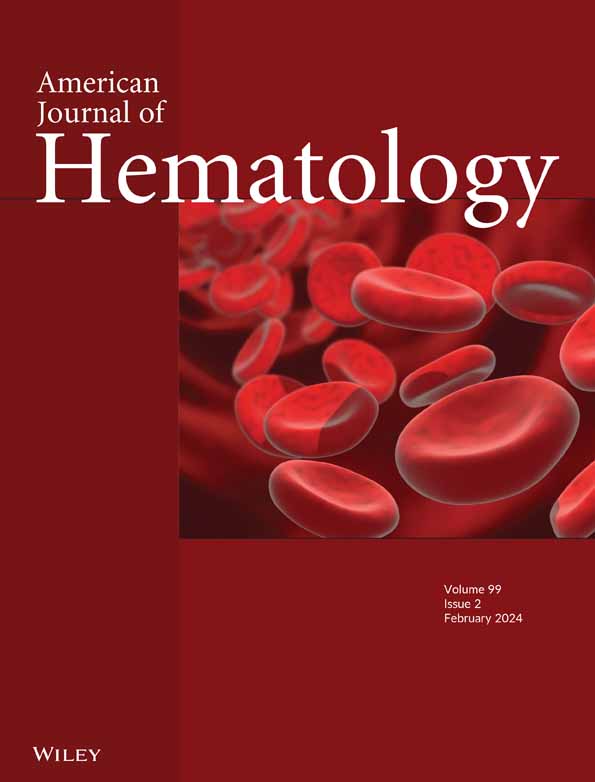慢性髓性白血病(CML)患儿的无治疗缓解率:塔塔纪念医院(TMH)儿科 CML(pCML)队列的前瞻性研究
IF 10.1
1区 医学
Q1 HEMATOLOGY
引用次数: 0
摘要
小儿慢性髓性白血病(pCML)是一种罕见的儿童恶性肿瘤,占所有儿童白血病的 2%-3%。酪氨酸激酶抑制剂(TKIs)大大提高了生存率,但由于其对儿童生长和骨骼健康的长期影响,也带来了挑战。我们对 45 名接受伊马替尼治疗的慢性期 pCML 患儿的无治疗缓解率(TFR)进行了前瞻性研究。资格标准符合现行的 NCCN 指南,每 3 个月进行一次不那么严格的 qPCR 监测。中位随访 25 个月(6-42 个月)后,71.1% 的患者(45 人中有 32 人)成功进行了 TFR。12 个月和 24 个月的 TFR 成功率分别为 70% 和 66%。5岁以下儿童的TFR率为88.9%,而5岁以上儿童的TFR率为61.8%(P = 0.18)。在停药后 6 个月内,13 名丧失 MMR 的患者中有 11 人丧失了 MMR。停药 6 个月、12 个月和 24 个月后 MMR 下降的累积发生率分别为 26.4%、27% 和 33%。13例停药失败(DF)患者中有10例(76.9%)在重新开始服用伊马替尼后3(2-20)个月内恢复了MMR。基线T调节细胞水平较高与DF之间存在明显相关性(p = 0.005)。超过一半的患者在 TFR 2 年后骨矿物质密度有所改善。我们的研究结果表明,pCML 患者可以达到较高的 TFR 率,从而为骨骼健康带来更多益处。较少的分子监测频率与不良结果无关,而且免疫系统似乎在维持 TFR 方面发挥了作用。该研究已在印度临床试验注册中心注册(CTRI/2020/11/029199)。本文章由计算机程序翻译,如有差异,请以英文原文为准。
Treatment-Free Remissions in Children With Chronic Myeloid Leukemia (CML): A Prospective Study From the Tata Memorial Hospital (TMH) Pediatric CML (pCML) Cohort
Pediatric chronic myeloid leukemia (pCML) is a rare childhood malignancy, representing 2%–3% of all childhood leukemia. Tyrosine kinase inhibitors (TKIs) have greatly improved survival but pose challenges due to their long-term effects on growth and bone health in children. We prospectively studied treatment-free remission (TFR) in 45 children with pCML in chronic phase on imatinib. Eligibility criteria were as per current NCCN guidelines, with a less stringent qPCR monitoring scheduled every 3 months. TFR was successful in 71.1% (32 out of 45) of patients after a median follow-up of 25 (range: 6–42) months. The TFR rates at 12 and 24 months were 70% and 66%, respectively. Children under 5 years had a TFR rate of 88.9%, compared to 61.8% in those over 5 years (p = 0.18). Eleven of the 13 patients who lost MMR did so within 6 months of discontinuation. The cumulative incidence of loss in MMR at 6, 12, and 24 months was 26.4%, 27%, and 33%, respectively. Ten out of 13 (76.9%) patients with discontinuation failure (DF) regained MMR within 3 (2–20) months of restarting imatinib. A significant correlation was found between higher T-regulatory cell levels at baseline and DF (p = 0.005). More than half patients showed improved bone mineral density after 2 years of TFR. Our findings suggest that high TFR rates can be attained in pCML, with added benefits for bone health. Less frequent molecular monitoring was not associated with adverse outcomes and there seems to be a role of the immune system in sustaining TFR. The study is registered in the Clinical Trials Registry-India (CTRI/2020/11/029199).
求助全文
通过发布文献求助,成功后即可免费获取论文全文。
去求助
来源期刊
CiteScore
15.70
自引率
3.90%
发文量
363
审稿时长
3-6 weeks
期刊介绍:
The American Journal of Hematology offers extensive coverage of experimental and clinical aspects of blood diseases in humans and animal models. The journal publishes original contributions in both non-malignant and malignant hematological diseases, encompassing clinical and basic studies in areas such as hemostasis, thrombosis, immunology, blood banking, and stem cell biology. Clinical translational reports highlighting innovative therapeutic approaches for the diagnosis and treatment of hematological diseases are actively encouraged.The American Journal of Hematology features regular original laboratory and clinical research articles, brief research reports, critical reviews, images in hematology, as well as letters and correspondence.

 求助内容:
求助内容: 应助结果提醒方式:
应助结果提醒方式:


